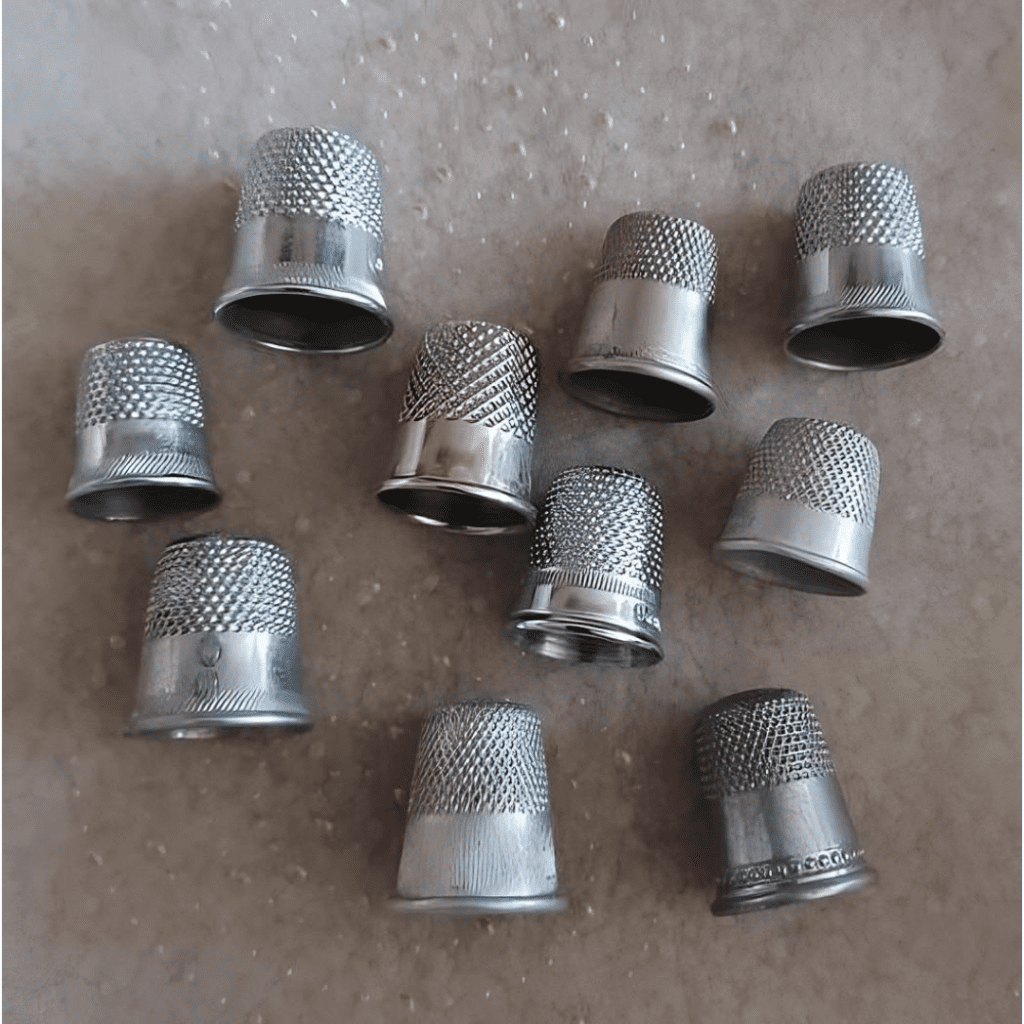Thimbles have been essential tools in the hands of sewers, crafters, and artisans for centuries. A symbol of skill, precision, and protection, thimbles safeguarded our grandmothers’ fingers, allowing them to create beautiful, durable garments. More than just sewing accessories, these little metal or leather caps are historical artifacts that tell stories of craftsmanship, culture, and creativity.
A Stitch in Time: The Ancient History of Thimbles
Thimbles may seem like simple tools, but their history dates back thousands of years. Archaeologists discovered some of the earliest examples of thimbles in ancient Roman sites, like Pompeii, where bronze thimbles were common as early as the 1st century AD. Even then, the purpose was clear: to protect fingers while pushing needles through fabric.

As time passed, thimbles became essential in everyday life. In medieval Europe, thimbles were handcrafted from various materials like leather, wood, and metal. By the 14th century, Nuremberg, Germany, had become a hub for producing brass thimbles, a trade that turned thimble-making into a respected craft. Over time, these small tools evolved from simple finger protectors into ornate items made of silver, gold, and precious stones, becoming status symbols among the wealthy.
The Rise of Decorative Thimbles: The 19th-Century Transformation
The Industrial Revolution of the 19th century dramatically changed thimble production. Factories began producing thimbles in large quantities, making them affordable and accessible to the general population. However, this accessibility didn’t mean a loss of artistry; on the contrary, thimbles became a canvas for intricate designs. Many were adorned with delicate engravings, floral patterns, and even small gemstones, making them as beautiful as they were functional.
These decorative thimbles became popular collectibles. From porcelain and bone china to sterling silver, thimbles were crafted from various materials and often gifted as treasured keepsakes. Many were handed down through generations, passed from mothers to daughters, creating lasting family heirlooms.
A Tool with Many Uses: How Thimbles Empowered Crafts and Trades
Primarily, thimbles were designed to protect the middle finger from needle pricks, allowing sewers to apply force without injury. But their use extended beyond sewing. Craftspeople in bookbinding, leatherworking, and lace-making all found thimbles essential. The added grip and protection made tasks easier and safer, especially when working with tough materials or small, detailed stitches.
Thimbles also appeared in unexpected places in popular culture. One of the original game pieces in Monopoly, a thimble symbolizes its common presence in early 20th-century households. In J.M. Barrie’s “Peter Pan,” Wendy gives Peter a thimble as a “kiss,” adding a touch of whimsy and symbolism to an otherwise humble tool.
Pantry to Heirloom: How Thimbles Became Collectible
Today, thimbles have taken on a new role as prized collector’s items. Vintage thimbles, particularly those from specific eras or made from unique materials like sterling silver or porcelain, are highly sought after by collectors worldwide. The historical significance, aesthetic appeal, and intricate craftsmanship of these pieces make them valued artifacts. Museums and exhibitions even showcase the rich legacy of thimbles, with displays that trace their evolution across cultures and centuries.
In Creglingen, Germany, the Fingerhut Museum stands as a tribute to these tiny tools. With thousands of thimbles from different regions and periods, this museum honors the thimble’s historical journey. Each piece tells its own story, reflecting not only changes in craftsmanship but also shifts in societal values and cultural practices.
The Modern Artisan’s Nod to Tradition: Thimbles in Contemporary Crafting
While industrialization made mass production possible, modern artisans have embraced thimbles as part of a return to traditional craftsmanship. Many crafters today use vintage or custom-designed thimbles to honor their heritage while adding a personal touch to their work. Artisans blend traditional designs with contemporary aesthetics, creating thimbles that pay homage to the past while appealing to today’s tastes.
The modern thimble may be made from stainless steel, leather, or even rubber, depending on the type of work and the user’s preference. Crafters still appreciate their utility and often choose thimbles that reflect their unique style, proving that this tool remains as relevant and functional as ever.
Why Thimbles Remain Essential in Crafting History
Despite advances in technology and the introduction of sewing machines, thimbles maintain their place in the world of craftsmanship. Their story is one of resilience, adapting over centuries while preserving their fundamental purpose. For our grandmothers, and many generations before them, the thimble was an essential part of their toolkit, a small but mighty companion in their daily lives.
The thimble’s legacy is more than practical; it’s symbolic. It reflects the dedication, patience, and artistry required in sewing and other crafts. This tiny tool speaks to the endurance of tradition, craftsmanship, and a time when creating by hand was not only valued but cherished.
Conclusion: Thimbles as a Symbol of Craft and Heritage
From ancient Rome to modern artisans, thimbles have woven a rich tapestry of history, skill, and creativity. They are more than just sewing tools—they’re artifacts of culture and symbols of our grandmothers’ resilience and resourcefulness. As collectibles, they connect us to a bygone era, reminding us of the beauty in everyday objects and the stories embedded in simple tools. While the golden age of handcrafted thimbles may have passed, their significance endures, preserved by collectors and artisans who continue to find inspiration in these small, yet remarkable, tokens of history.